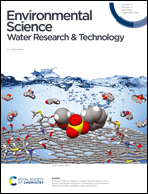Robustness of partial denitrification-anammox (PdNA) in filters with methanol and glycerol as carbon sources†
Abstract
Partial denitrification-anammox (PdNA) has a significant application potential for retrofitting plants for more intensified and cost-effective nitrogen removal. Therefore, demonstrating the reliability and robustness of PdNA in polishing filters will advance its full-scale applications. In this study, methanol and glycerol were used as carbon sources with carbon demands of 2.05 and 2.54 g CODadded g TINremoved−1, and showed up to 80% TIN removal through the anammox pathway, leading to potential carbon savings of up to 65% compared to conventional denitrification filters. The higher partial denitrification efficiency (67% ± 12% vs. 59% ± 12%) and PdNA rate (437 ± 213 vs. 397 ± 205 g N m−3 d−1) of glycerol did not compensate for its higher biomass yield and cost (currently in the Mid-Atlantic region of the United States), thus making methanol the preferred carbon source. Anammox capacity more than 1.5 times the daily requirements was maintained in the filters at temperatures as low as 14 °C. In addition, under aggressive backwash conditions in the order of 5.5 h, there was no loss of anammox performance. Therefore, anammox are not the limiting step in PdNA filters, rather the ability of PdNA filters to achieve low effluent total nitrogen limits below 3 mg TIN L−1 is primarily dependent on the aeration control in the upstream activated sludge to provide the appropriate ratio of ammonium to NOx.



 Please wait while we load your content...
Please wait while we load your content...